Two weeks ago I was in Tokyo.
About a month from now, players from all over the world will be gathering for Worlds in Chiba, about an hour and a half from central Tokyo on the Sobu Line. Their first challenge will be six rounds of Standard in an environment that will be just over two months old when Day 1 begins.
So, one month shy of the mark, what can we say about Zendikar-M11-Scars Standard?
Today I’m going to take a “thousand-foot” look at the current Standard metagame. But first I’ll introduce myself and talk a little bit about what we can — and can’t — glean from metagame analysis. Then I’ll come back to take a look at the metagame stage ahead of Chiba.
Hello!
This is my first time writing for StarCityGames.com, and I’m really excited to be here. Instead of porting some of my other topics here, I’m starting up a whole new ongoing series of metagame analyses focusing on relevant Constructed formats. The goal is to give you an interesting and hopefully useful window into the ongoing Constructed metagame, be it Standard, Extended, Legacy, or, should the PTQ season require it, Block.
In some articles, like this one, I’ll be doing a general, high-level review. Others will involve drilling down on one aspect of the current metagame, such as tempo, or a specific archetype or sets of archetypes. One of the joys of Magic, for me, is surveying the composition of ongoing metagames and asking questions like, “Does aggro really
always
dominate early in the season?”
The answer to that last one, if you’re curious, is no. It’s sometimes true, but far from a general rule.
So, I’m kind of a metagame junkie, as are many of you. What, exactly, is that worth?
Why we analyze
If we’re honest with ourselves, the number one reason we like to look at the metagame is because we enjoy staring at decklists just like my car
aficionado friends like to leaf through exotic car magazines. They’re not going to buy an
Aperta,
and we’re not going to do anything more than idly window-shop most of the decklists we see.
But there are actual, functional reasons, and they’re worth some explicit discussion.
The best deck!
Well, not so much.
Except on rare occasions — like the Faeries scourge — tournament results don’t give us a solid read on the “best” deck. In fact, they don’t so much tell us about which decks
will
win as they tell us which decks people happened to play that ended up winning.
If that seems like an unnecessarily fine distinction, that’s okay. The upshot is that there could be a better deck that hasn’t surfaced yet, but at least we can figure out what’s being played right now, what’s winning right now… and how those decks are built.
It’s that second part that’s especially interesting to me, since we can dig down beyond simply “Hey, Valakut’s winning” and take a look at the range of options that fit into that Valakut bin.
Big events, small events
It’s tempting to focus on what I habitually call “premier events” (following the Magic Online naming conventions), such as Pro Tours, Grand Prix, and the StarCityGames.com Open Series. These tend to be bigger events, and at least among the folks who make it to the upper end of the standings, there are high-level players who can be expected to bring their A games and to provide a solid testing ground for deck builds.
On the other hand, the sample size is small.
In contrast, especially for Standard, we have a host of Daily Events firing off on Magic Online. I’ve spoken to a lot of players who like to deride Dailies — “It’s only four rounds!” But the trick is that the sample size here is quite large, so if an archetype or design pops up to the top of the heap repeatedly, it’s probably solid.
I’m a biologist by trade, and we get to deal with both kinds of data. The same is true in medicine as well. It’s helpful to have detailed case reports, and it’s important to have large-scale clinical trials to validate the leads generated by those reports.
So the punch line is that I consider “all of the above,” spreading my focus across Premier Events and Dailies alike.
A swath of Scars
For this first edition of The Field Report, I wanted to pull together a high-level overview of the Zendikar-M11-Scars metagame. Like most of you, I’ve had an intuitive feel for what’s showing up in tournaments, but I’ve also read a lot of arguments back and forth over things like “Is U/W Control a real deck?” and have developed a narrative impression of the metagame that might not have anything to do with the actual metagame.
For today’s analysis, I surveyed a combination of Magic Online Standard Daily events as well as several premier events including the StarCityGames.com Open Series tournaments in Nashville and Charlotte. On the Magic Online side, this meant tallying the 4-0 and 3-1 decks from 58 Standard Daily Events covering the period from October 21 through October 31, for a grand total of 847 decks from Dailies.
So what did I learn?
Top performers at premier events
Combing the results from Charlotte, Nashville, and a couple other premier events, we see the following high-level metagame breakdown:
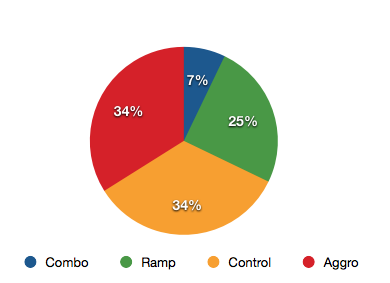
This is obviously a super-high-level abstraction, breaking the metagame down into clumsy,
Duplo-sized
chunks.
Nonetheless, it’s a fascinating first step, especially in light of the MTGO Daily analysis below.
We see an even split between Control and Aggro archetypes, with Ramp living in its own special space alongside a reasonable, if minor, sliver of Combo.
But at least during the current Standard, I think the batching of all Aggro decks into one supersized category is misleading at best, since this forces the “Aggro” label to cover a motley crew including Elves, Fauna Shaman decks, and Boros. With that in mind, I split the Aggro category out into some reasonable parts, like so:
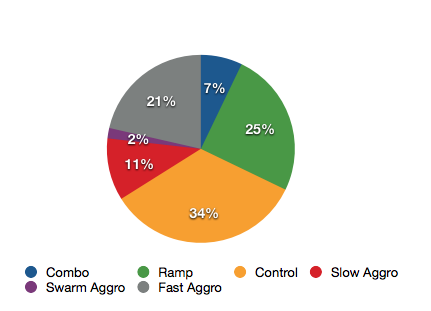
This makes the breakdown of Aggro decks more clear. “Swarm Aggro” in this case means
Elves,
although it can also include various Tokens and
Overrun-style decks. “Fast Aggro” includes Boros,
Quest Aggro,
Mono-Red Aggro,
and
Kuldotha Rebirth
decks. Finally, “Slow Aggro” includes
Fauna Shaman
and Vampires decks. For your convenience, I’ve linked names to a representative deck design.
Digging in a little deeper on the Control side, we see the kind of distribution you might expect if you’ve been reading a lot of Magic writing lately — seven
U/B Control
decks, seven more
U/R/G Jace
decks, and a mere three
U/W Control
builds.
That certainly fits the narrative of U/W Control not being a “real deck,” at least to some extent.
Ramp is a 2:1 mix of
Valakut
and
Eldrazi
decks.
Finally, “Combo” refers to just the burn-oriented variation of
Pyromancer Ascension.
If we stopped right here, the take-home lesson would be to plan for Control most of the time, with a generous side-helping of Ramp, enough Fast Aggro to kick your teeth in, and a sliver of Pyromancer Ascension.
Top performers in MTGO Dailies
I view Magic Online Daily events as a sort of proxy for the opening rounds of a tournament. The early rounds kick out the decks that are in no shape to compete, and a deck that can let its pilot make a 3-1 or 4-0 result is a reasonable choice for a larger tournament… or, say, for the first day at Chiba, when you want to hit at least a 4-2 to keep yourself alive going into Days 2 and 3.
Following from this “proxy” view, decks that frequently make 3-1 records are ones you should
expect
to run into generally, and decks that frequently make 4-0 records are those that you should be on the lookout for when you’re doing reasonably well in the later rounds of a tournament.
Here’s that same high-level view across 168 4-0 performers in Standard Daily events:
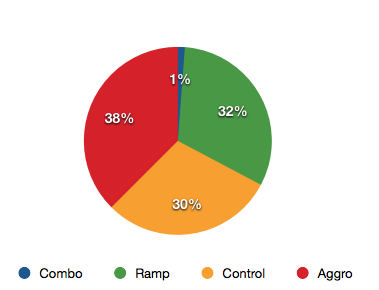
The clearest distinction between these results and the premier event results above is the narrowing of the combo slice from a reasonable 7% to a mere 1%. If we turn our attention to the 3-1 performers, we see this:
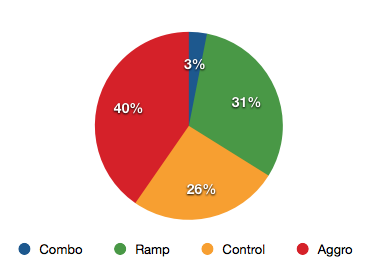
Interestingly, it looks like more players are bringing combo decks to the party than manage to succeed with them. Much more to the point, the 4-0 results show a 30% slice of the pie for Control, versus the 26% we see among the 3-1s.
Over in biology, we’d tend to say that the 4-0s are “enriched” for Control decks. And if we look back to the premier event results, we see a 34% slice going to Control — even more enrichment.
It may be a stereotype, but we might reasonably conclude that skilled players are choosing to run Control. We also have an abstract, but useful view of what it might be like for players at Chiba as they climb through the first six rounds of Standard — or you, as you face down your next FNM or premier event. The “you must be this tall to ride this ride” metric for the first several rounds is likely to be your ability to defeat Aggro and Ramp decks, but as you make your way up through the standings, you should be prepared to find the most skilled opposition running Control.
Breaking down Aggro
As with the premier events, it’s probably misleading to lump all the possible variations of Aggro into one big pile. With that in mind, we want to break the individual categories out as before. To save you the effort of scrolling back up, here’s the premier event Aggro breakdown one more time:

Here’s the same breakdown for the Daily 4-0s:
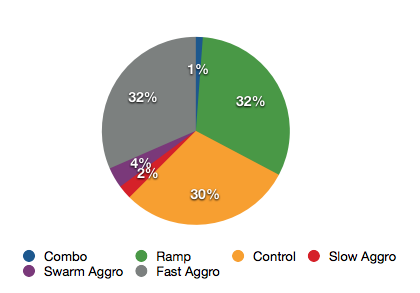
…and for the Daily 3-1s:
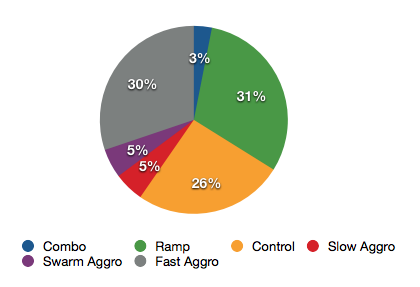
The divergence between the Aggro breakdown at the premier and Daily levels really took me off guard here. Just short of a third of the Aggro decks at the premier level were Slow Aggro — mostly Fauna Shaman decks, really. In contrast, Fauna Shaman decks (and friends) barely make a dent at either the 4-0 and 3-1 levels.
One conclusion we might reach there is “good players play Fauna Shaman.” We might also imagine that the real answer is “Vengevine is expensive,” but that applies so much more to Jace, and the Mind Sculptor appears about 200 times in the 4-0s and nearly 700 times in the 3-1s. Compared to dropping 340+ tix for a playset of Jaces, the Vengevines are just garnish.
The disparity between the abundance of Fauna Shaman and Pyromancer Ascension decks at premier versus Daily events is fascinating, and may mean something cool, or nothing at all. On the “something cool” side, it could be that Fauna Shaman and Pyromancer Ascension decks are particularly complex and difficult to play, and thus only work well in the hands of skilled players. On the “nothing at all” side, we have to recall that the premier events are a small sample (even if each one has many players), so the presence of more Ascension and Shaman decks in the Top 16 could be a pure outlier.
It happens.
A window into specific archetypes
I won’t dwell on it today, but here are the major archetypes that have seen some amount of success in the Magic Online Dailies. First, the 4-0s:
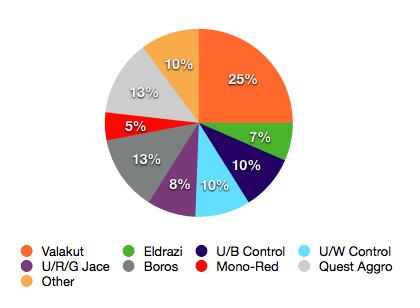
…and the 3-0s:
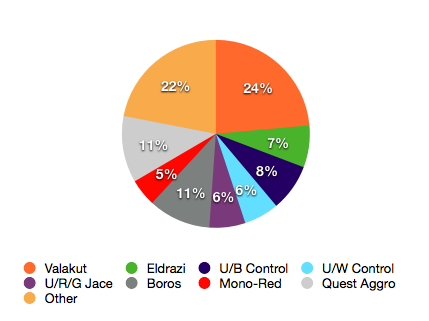
The archetypes in each section are fairly straightforward. What’s probably most interesting is the halving of the “Other” category as we go from the 3-1s to the 4-0s.
But I’ll return to that culling effect sometime in the future.
The pace of Standard
As I said in the intro, future articles will focus on specific aspects of the metagame, including tempo. Tempo is an especially important consideration when we, like the players swarming toward Chiba, are trying to decide how we might try to break the format, or if that’s even possible.
Briefly, if you’re slower than the format, you’re going to lose.
Given that the bulk of our current metagame is a mix of Ramp, Control, and Aggro, these three decks give us our basic speed metrics for any tournament we might attend.
I like to think about tempo by using abstractions. Abstracting a deck design involves taking the deck’s cards, stripping away their specific names, and placing them along the mana curve based on the turn when they impact the game in a given area. For example, a Wurmcoil Engine, being a six-mana, non-hasty creature, impacts the game as a threat at the seven mana mark — six mana to cast it, one more turn to get it started, so to speak. So it’s a seven-mana threat. On the other hand, it has an impact on turn 6 as a disruption for opposing, creature-based attack strategies, so it’s a six-mana spell in that role.
Abstracting Valakut
Consider, for example, the following pair of Valakut decks taken from recent tournament results. Just the maindecks are shown, sans sideboards.
Creatures (10)
Lands (28)
Spells (22)

Creatures (13)
Lands (27)
Spells (21)

>
If neither deck had any acceleration, their threat curves would look like this:
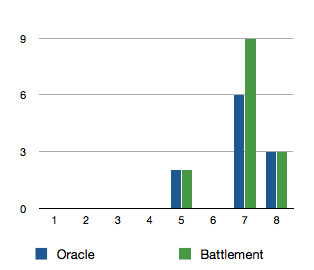
Those would be terrible decks.
What you’re looking at there is an abstract representation of where the potentially game-ending threats, such as Primeval Titan, fall on the curve. Note that this explicitly includes threats such as Raging Ravine and Valakut itself, although I’ll defer explaining exactly how that works to a future column.
Of course, acceleration exists, and that cranks the curve forward dramatically. I’ll discuss this more in a future piece, but the net result is the following pair of threat curves (contrasted with the unmodified for ease of viewing):
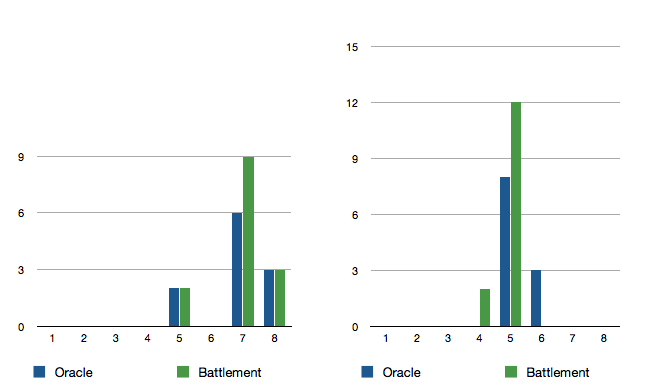
That really highlights just why Valakut can be such a grotesque deck to face down — with reasonable acceleration, threats that “should have” gone active on turns 7 and 8 instead get going on turns 4, 5, and 6. Ugly.
I’ll end this brief burst of tempo with the following graphic for you to ponder:
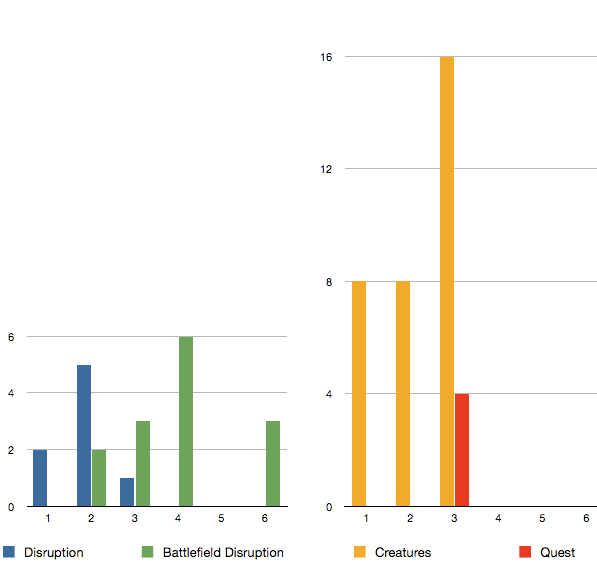
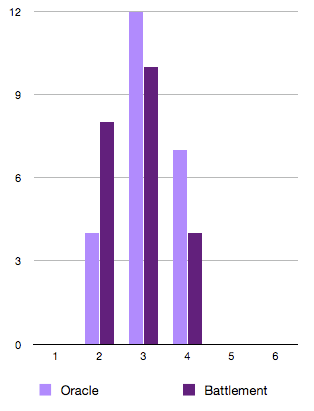
The deck on the top left is a typical U/B Control build, with disruption such as counterspells and discard noted on the curve in blue, and “on board” disruption such as Into the Roil, Doom Blade, and Jace, the Mind Sculptor noted on the curve in green. The top right curve belongs to the threats in a Quest Aggro build, with creatures in yellow and the successful activation of Quest for the Holy Relic in red. Finally, the same two Valakut decks, in their acceleration-adjusted forms, grace the bottom of the graphic.
These graphics tell the basic story of the current metagame’s tempo pretty well. Control decks, like the U/B example, devote their early game to stonewalling the opponent’s ability to play and their late game to screwing the opponent up once their stuff hits play. Quest Aggro decks form the extreme end of “Fast Aggro,” vomiting creatures onto the board and hoping to overwhelm the Disruption phase of the control game and make the kill before Battlefield Disruption comes online… or, in the case of facing down Ramp, to just make the kill before Ramp threats start resolving — although the degree of overlap between the mid-late Quest game and the early-to-mid Ramp game shows why this is often a dicey proposition.
But more on that in future articles. For now, that’s just a neat little snapshot of the pace of Standard right now, in the month before Chiba.
Angling in from a thousand feet
That’s my current “thousand-foot” view of the Standard metagame. In the next few installments of his column, I’m looking forward to focusing in on specific topics such as the full range of Valakut decks out there (Battlement, Oracle, or none of the above? Is Wurmcoil a necessary threat or a distraction from plan A?), the relative pace of the major archetypes, and whether there are any upcoming decks in the “pre-breakout” phase, ready to crash full-bore into the Standard day at Worlds.
I’d also love to hear your feedback. What questions do you have about the metagame? What assumptions would you like to see tested by a thorough review of the winning decks and archetypes? Let me know in the comments, and I’ll look forward to seeing you next time when I descend from the thousand-foot mark and take a closer look at the Standard metagame.
